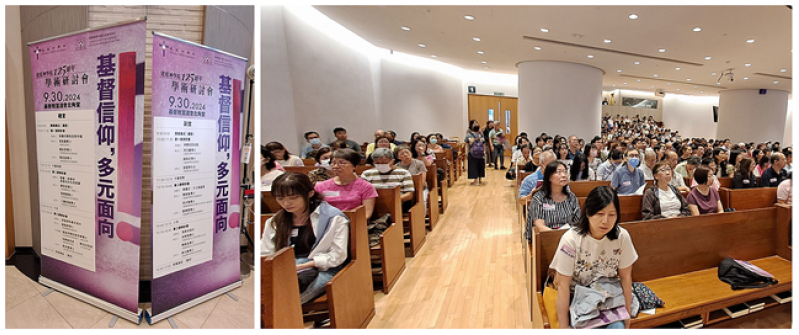
At Alliance Bible Seminary (ABS, 建道神学院)’s 125th anniversary academic forum, ABS Department of Theological Research & Studies associate professor Dr. Chan Chi Heng (陈智衡) presented a thesis titled: “Unfinished Unity: the ‘United Church of Hong Kong’ Project”. In this paper, he traced the history of ecumenism and how the Chinese church denominations have merged over the years. Dr Chan called for all church denominations in Hong Kong to avoid fighting over their differences, and to face social challenges together.
Ecumenism and the Merging of Chinese Church Denominations
Dr. Chan pointed out that the Christian movement of ecumenism can be traced back to the start of the 20th century. Since the 1910 World Missionary Conference held in Edinburgh, England, the movement was carried over to China. Pioneers first established the China Continuation Committee (中华续行委办会), which then became the National Christian Council of China (中华全国基督教协进会). This provided the foundation for the unification of Christianity in China.
At the same time, the Presbyterian church, the Congregational Church, and London Missionary Society, and other denominations came together to form the Church of Christ in China (CCC, 中华基督教会), a coalition of churches in mainland China. It was the largest church network and soon came to establish a national headquarters (中华基督教会全国总会) in 1927, ministering to over 120,000 believers (a third of the entire Chinese Christian population). It was a unified church formed from seventeen units.
Ecumenism in 20th Century Hong Kong
Hong Kong was a British colony in the 19th century, and missionaries from various denominations were evangelizing and establishing a number of local churches. They operated independently until 1915 when the Hong Kong Chinese Christian Churches Union (HKCCCU, 香港华人基督教联会) was formally established. It became a platform for early Hong Kong churches to collaborate and was at the same time a non-affiliated liaison organization. The newly formed federation enabled churches to cooperate in common ministries, including Christian cemeteries, nursing homes, and Sunday school.
In the post-war period, the Hong Kong Christian Council (HKCC, 香港基督教协进会), established in 1954, became another important institutional organization to promote ecumenism among the churches, aiming to foster overall cooperation in Christianity in Hong Kong.
Traditional Denominations Experimenting with Church Unification
Plans and action for unity among the churches can be traced back to 1966, when Rev. Peter Wang (汪彼得), the General Secretary of the CCC, issued the “Ten-Year Development Plan” for Chinese churches. Rev. Wang emphasized that “We believe the unity of the Church is God’s will.” He said that, following the teachings of Jesus Christ, if they continued to persevere, they could realize the unification of Christianity in Hong Kong within the next ten years. This confidence was in part influenced by the newly established United Methodist Church in the United States.
In February 1967, the Methodist Church, United Methodist Church, and Hong Kong CCC began researching church unification, starting in-depth discussion and collaboration.
Collaboration and Exchanging Pulpits
As part of the effort to unify the church, many mainstream church groups started collaborating with one another. After the first joint meeting, the Hong Kong CCC, which had been supporting the Church of the United Brethren in Christ (同寅会), hoped to increase collaboration among the churches. A meeting was held again on March 7, 1968, and the committee passed a five-part act of recommendations to promote such collaborations. The recommendations included exchanging pulpits, holding joint cell meetings, public gatherings, etc.
The United Methodist Church held an interim annual conference in October 1967, where they shared the initial contacts that had been made with the Methodist Church. They noted that the two churches shared the same roots in history and faith and looked forward to forming a closer relationship.
In addition, the Anglican Communion has actively promoted the process of united churches. In 1971, the Governor of the Anglican Church, John White, was invited to address the Methodist Conference, suggesting that at least four of the major church bodies in Hong Kong (UMC, Methodist, Anglican, and CCC) had reached a basic consensus of faith and order, recognizing each other's authority in the Scriptures, and the significance of Holy Baptism and the Eucharist.
Unification Ended but Churches Should Still Stand Together to Face Social Challenges
Despite extensive collaboration, the ecumenism movement still faced significant challenges. Issues surrounding episcopacy and recognition of ordinances were topics of intense discussion and slowed down the unification process. Although the plan was not executed perfectly, the church leaders involved in the movement to this day still maintain good terms and multi-faceted collaborations.
Dr. Chan concluded that, in the current social environment, it is important for denominations and churches, in their independence, to flexibly respond to the ever-changing needs of the times. This may be the more suitable direction to take for modern ecumenism. Because of this, denominations and churches should avoid infighting over their differences on the foundation of understanding and collaboration to face the challenges and needs of modern society.







